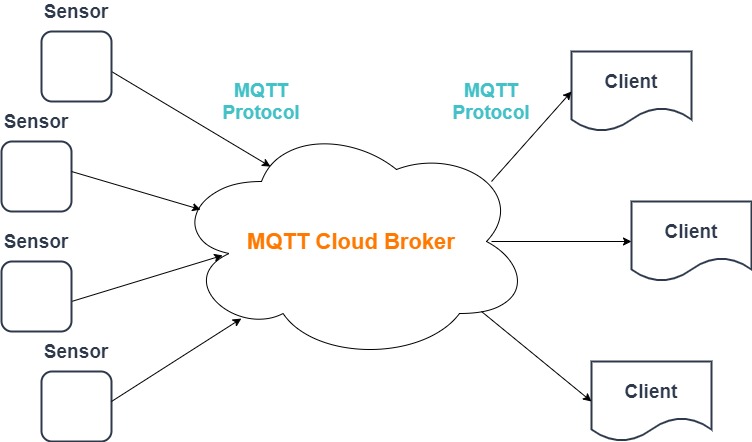With the widespread transition of technology to the level of work with the Internet of Things, it became necessary to process and manage a large amount of information exchanged between devices on the network. On the other hand, the dynamic development of cloud technologies made it possible to connect the two technologies together, which solves the problem of managing and processing information from the Internet of Things in the cloud.
More than twenty years ago, the need arose for servicing Internet-connected devices in industry and household applications. In 1999, Andy Stanford-Clark (IBM) and Arlen Nipper (Cirrus Link/Eurotech) created the first version of the protocol for managing and monitoring connected devices. This protocol was first used in practice for monitoring an oil pipeline in the desert. In this task, it was necessary to have a protocol with efficient use of the bandwidth of the low-speed data channel. It needed to be simple and consume little battery power, and include the possibility of the device functioning via satellite communication.
The MQTT full form is “message queuing telemetry transport.” The protocol was created to solve these kinds of problems. Accordingly, server solutions (in particular messaging brokers), were needed to serve the operation of this protocol.
And since cloud solutions are currently distributed in almost all areas of information technology, the corresponding cloud systems have appeared in the field of management and monitoring of the Internet of Things.
MQTT protocol for Internet of Things
The MQTT protocol focuses on ease of use, low load on communication channels, work in the conditions of constant loss of communication, and easy integration into any system. Its main purpose is to work with telemetry from various sensors and devices. The use of a subscriber template allows devices to communicate and publish messages that are not previously known or predetermined. In particular, the protocol does not impose restrictions on the format of the transmitted data.
MQTT was developed as a simplified network protocol running on top of TCP/IP, oriented to exchange messages between devices on the principle of publisher-subscriber. MQTT-SN can work on top of other networks, such as Zigbee.
MQTT devices use certain types of messages to interact with the broker. The following are the main ones:
- Connect - establish a connection with a broker. Waits for a connection to be established with the server and creates a link between the nodes.
- Disconnect - disconnect from the broker. Waits for the MQTT client to finish any work it must do, and for the TCP/IP session to disconnect.
- Publish - publish data to the topic on the broker. Returns immediately to the application thread after passing the request to the MQTT client.
- Subscribe - subscribe to the topic on the broker. Allows receiving data from specific devices to specific subscribers.
- Unsubscribe - unsubscribe from the topic. Stops receiving messages from specific devices.
Here is a list of key features of the MQTT protocol:
- Asynchronous protocol
- Compact messages
- Work in conditions of unstable communication on a data line
- Support for multiple levels of quality of service (QoS)
- Easy integration of new devices
The MQTT protocol runs at the application level over TCP / IP and uses the default port 1883 (8883 when connecting via SSL). As an alternative to the MQTT protocol, IoT devices can use the HTTP / REST-based protocol. But the REST protocol was invented a little later and is more resource-intensive compared to MQTT. The MQTT 3.1.1 specification was standardized by the OASIS consortium in 2014.
What is the MQTT broker?
The broker is the main element of the publisher-subscriber system. It is responsible for receiving all messages, filtering them, deciding who is interested in these messages, and, ultimately, for sending messages to all subscriber clients.
Thus, many subscribers can be subscribed to a variety of topics and, depending on these subscriptions, receive the information they need without communicating directly with the publisher.
Among the server implementations of the broker (both on-premises and cloud), we can distinguish IBM WebSphere MQ; the Mosquitto open-source MQTT broker is based on Eurotech Everyware Device Cloud, easily scalable and high-performance open server emqttd, allows you to serve more than a million connections; HiveMQ broker providing corporate security and maximum scalability. The broker can store the data in the form of retained messages (need to subscribe with database client) so that new subscribers to the topic can get the last value straight away. The broker also keeps track of all the session’s information as the devices go on and off, called “persistent sessions”.
The main advantages of MQTT broker are the following:
- Solves the problem of vulnerable and insecure client connections
- Designed to easily scale from one device to hundreds of thousands
- Manages and monitors all client connection states
- Enables the transfer of credentials and security certificates.
- Significantly reduces network load without compromising security
- Can be used in a cellular or satellite network to work with remote devices
One of the most common on-premises broker options is Mosquitto. As mentioned on their site “Eclipse Mosquitto is an open-source (EPL/EDL licensed) message broker that implements the MQTT protocol versions 5.0, 3.1.1 and 3.1. Mosquitto is lightweight and is suitable for use on all devices from low power single board computers to full servers.” Mosquitto is highly portable and available for a wide range of platforms and can be run even on Raspberry Pi and other small scale platforms. This solution also can be placed in the IaaS cloud.
Why using the cloud for MQTT brokers?
MQTT on-premises broker is a rather time-consuming and demanding solution for your project. If we are talking about the quick launch of the solution for the Internet of things, then launching your own data center with a server for the MQTT broker will require resources for the initial launch and installation. Then you will need to allocate a system administrator resource to accompany the 24/7 solution. Plus, expanding and scaling the on-premises broker creates a lot of problems when migrating to new servers. It is also difficult to organize duplication of services for quick switching in case of failure of the main broker.

Now let's compare this solution with a cloud service, where for a minimal cost you can quickly connect your project to high-quality service and start using the MQTT protocol. With a cloud service, you also get support for your project and an already configured security system on the server and the ability to increase your capacities almost without limit. Placing the MQTT broker in the cloud can be a successful strategy both for small projects and for corporate-level projects.
Main MQTT Brokers in the cloud
Let's look at the main cloud MQTT brokers; this list is quite voluminous, but not complete. If you are looking for an MQTT broker online, please refer to the list below. You can always search for the necessary cloud solution that will satisfy your project in terms of functionality and cost. Let’s take a look at an MQTT broker comparison and define the most popular message brokers available today.
Adafrut. Adafruit IO supports MQTT, or message queue telemetry transport, which is a protocol for device communication. To use the MQTT API the Adafruit IO MQTT client library can be used. For Python, Ruby, and Arduino there are Adafruit's IO libraries as they include support for MQTT. For other languages or platforms look for an MQTT library that supports the MQTT 3.1.1 protocol. Adafruit recommends connecting using SSL (Port 8883). Port 443 is available for MQTT-over-Websockets clients which generally run in browsers, like Eclipse Paho, HiveMQ Websockets, or MQTTJS. Adafruit IO MQTT API supports QoS level 0 (at most once) and 1 (at least once) only. QoS level 2 is not supported.
Amazon. AWS IoT Core supports MQTT Quality of Service (QoS) levels 0 and 1 only. AWS IoT Core does not support publishing or subscribing to QoS level 2. The AWS IoT message broker does not send a PUBACK or SUBACK with QoS level 2. A user can connect to AWS IoT Core over MQTT by using one of the AWS IoT SDKs. Amazon also provides AWS IoT MQTT client, to help test the MQTT messages sent by a device. AWS IoT MQTT client allows subscribing to given topics to see necessary messages.
Cloud MQTT. This cloud solution provides a hosted message broker for the Internet of Things. The CloudMQTT bridge is a managed Mosquitto server in the cloud. Mosquitto implements MQTT, which provides lightweight methods of carrying out messaging using a publish/subscribe message queueing model. CloudMQTT provides easy scaling the broker or patching the platform. Also, there is a simple mechanism for integrating Kinesis with CloudMQTT. It is a relatively cost-effective service, 25 users/ACL rules/connections can be managed for $5 per month, 20 Kbit/s connections.
Eclipse MQTT. The Eclipse Paho project provides open-source client implementations of MQTT and MQTT-SN messaging protocols aimed at new, existing, and emerging applications for the Internet of Things (IoT). This broker is primarily intended for testing and is not intended to store or transmit confidential information. To connect to the server, you may use the following parameters: server iot.eclipse.org, port 1883; for TLS v1.2, v1.1 or v1.0 please use port 8883. Connection via WebSockets is also available.
Google Cloud IoT Core. Google Cloud IoT is a complete set of tools to connect, process, store, and analyze data both at the edge and in the cloud. The platform consists of scalable, fully-managed cloud services. An integrated software stack for edge/on-premises computing with machine learning capabilities for all client’s IoT needs. Devices can use the MQTT bridge to communicate with Cloud IoT Core by HTTP and MQTT. As mentioned in Cloud IoT documentation, “The MQTT standard is defined for implementing a full publish/subscribe broker. However, the managed MQTT bridge run by Cloud IoT Core does not support all publish/subscribe operations, such as creating arbitrary topics that devices can use to send messages between them.”
Heroku. Heroku CloudMQTT is an add-on for providing an MQTT broker to your application. CloudMQTT can be attached to a Heroku application via the CLI. Free with offering up to 10 customers connected. Heroku supports MQTT protocol with clients in Java, C, Python, Node.js, Ruby, Objective-C, etc. And so, if you are looking for a free MQTT server, then this is probably the best, if not the only solution to this problem.
Hivemq. HiveMQ's MQTT broker is designed for cloud-native deployments to make optimal use of cloud resources. Its use of MQTT reduces network bandwidth required for moving data. HiveMQ's MQTT broker makes it easy to move data to and from connected devices in an efficient, fast and reliable manner. Also, HiveMQ and MQTT can deliver the core infrastructure for a connected car platform. They provide reference architecture using HiveMQ to implement a VDA 5050 compliant system and performance test for 10 million devices benchmark. For public channels, HiveMQ is available for free.
IBM. The IBM IoT Platform provides simple, but powerful, services capable of interconnecting different kinds of devices and applications all over the world. The IoT Platform supports MQTT, the Message Queue Telemetry Transport, which is a lightweight and flexible network protocol. In MQTT terms, the IBM IoT Platform service acts as the broker and is thus responsible for distributing messages to connected clients (devices and applications). Devices include machines that publish information they detect, and applications are the programs that consume the information received from those devices. There are also several client libraries specific to the Watson IoT Platform, as the Java library is most popular.
Microsoft Azure IoT. The IoT Hub allows devices to interact with the endpoints of the IoT devices using: MQTT v 3.1.1 on port 8883 and MQTT protocol version 3.1.1 via WebSocket on port 443. It also allows integration with the SDK Microsoft Azure IoT. A device can use the MQTT protocol to connect to the IoT center using the Azure IoT SDK or use the MQTT protocol directly. Microsoft Azure allows you to use such programming languages to work with devices as Javascript (Node.js), Java, C#, Python.
mqtt.flespi.io. The flespi team has been working to add the MQTT 5.0 specification support into the broker to enhance productivity and scalability. Each flespi user operates in an isolated MQTT topic namespace. Service also provided REST API for managing sessions, publish messages, read and delete retained messages, and access logs. It also supports MQTT over SSL and MQTT over Secure WebSocket.
There are many options to find a proper online MQTT broker for your project. If your system is already running on a specific cloud system, you can choose the appropriate MQTT broker in the same cloud infrastructure to stay within the same cloud provider.
Conclusion
In Svitla Systems practice, support for the standardized MQTT protocol in cloud systems is very relevant nowadays for building reliable and scalable systems for working with data collection and processing devices. Cloud systems reduce the load on their own data centers, and if necessary, their own private cloud can be deployed at the corporate level and there is an MQTT support broker, which now has a sufficient number. This standard is valuable in that it is supported by a mass of off-the-shelf devices, and building a monitoring or control system from scratch is not a daunting task. On the other hand, if you need to make your own device for connecting via MQTT to an already working system, the client part can be implemented using the appropriate libraries, of which there is a large selection for various hardware platforms.
Choosing a cloud provider to service MQTT also gives you a lot of options now and you can use the message broker in your existing cloud, or choose the most suitable for your task. For a small number of clients, it is even possible to find an MQTT broker for free. Additionally, if you have a need to create a public MQTT channel, there is a solution to do this properly and for free: HiveMQ.
If you need to work with cloud systems and MQTT brokers, you can contact our company where experts with experience will design and configure the necessary system and help with the support of existing projects.





![[Blog cover] SEO optimization best practices](https://svitla.com/wp-content/uploads/2025/05/Blog-cover-SEO-optimization-best-practices-560x310.jpg)